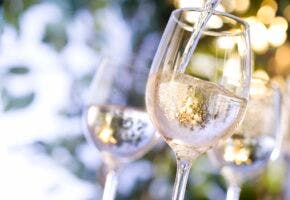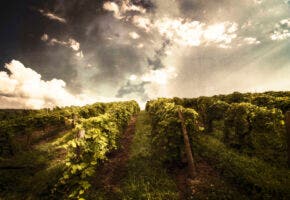What is Riesling
Pronunciation: REE-sling
Riesling is a hardy white wine grape that thrives in cool-climate wine regions. The versatile grape variety produces a wide range of dry and sweet wines, usually light in alcohol. The wines are either still or sparkling. Wines made from Riesling fruit range from pale yellow to rich gold in color.
Riesling’s bracing acidity contributes to the wine’s ability to age. German producers label their wines “trocken” for dry wines—less than 9 grams per liter of residual sugar. They label their wines “halbtrocken” for off-dry wines— about 9 to 18 grams per liter of residual sugar.
German Riesling is rarely fermented in small, new-oak barrels but is more often oaked in stainless steel tanks or large oak vats.
The small, round and white-green berries are susceptible to noble rot and in Germany produce wines at several levels of late-harvest ripeness including, in order of ascending sweetness, Spatlese, Auslese, Beerenauslese and Trockenbeerenauslese.
Checking the alcohol by volume (abv) on a Riesling label is the easiest way to gauge sweetness regardless of origin. The higher the abv, the more sugar was converted to alcohol resulting in a drier wine. Typically, anything at or above 12% abv will taste dry. Anything lower than 11.5% abv will exhibit sweetness.
Riesling Synonyms
Riesling can sometimes be labeled as Johannisberg Riesling, Rheinriesling, Weißer Riesling, Rizling Rýnsky, Rajnai Rizling, Renski Rizling, Rhine Riesling and Riesling Renano.
Riesling Regions
Riesling is most known for cool climate regions such as the Rheingau, Pfalz and Mosel regions in Germany and Alsace in France. Riesling is also farmed in cool-climate areas like New York’s Finger Lakes, Austria and Tasmania, and in warmer regions like South Australia, Washington and coastal parts of California.
Riesling Tasting Notes
Riesling’s distinctive aromatics sometimes include a petrol or gasoline character, but it is known mainly for its expressions of peaches, apricots, apples, pears, citrus and white flowers.
In Alsace, the wines usually are higher in alcohol than in Germany. The wines produced with fruit from Vendange Tardive (VT) and Sélection de Grains Nobles (SGN) are sweet.
Riesling grapes are found in sparkling, white, and dessert wines.
Structural Characteristics
Examples of Riesling to Try
Pairs Well With
Riesling wines can be paired with a wide range of foods, including fish, white meats, seafood, spices and vegetables.
Handling Tips
Fun Facts
- The first mentions of Riesling—as Riesslingen —date from the early 15th century in what is now Germany. In 1552, German botanist and physician, Hieronymous Bock, documented Riesling in his Kreutterbuch plant book.
- The grape’s popularity grew after The Elector and Archbishop of Trier in 1787 decreed that all “bad” wines should be replaced with Riesling. By the 1850s, Riesling fetched higher prices than Bordeaux or Champagne wines.
- Germany is the world’s largest producer of Riesling.
- A small amount of Riesling is produced in the Napa Valley of California even though Cabernet Sauvignon remains king.














